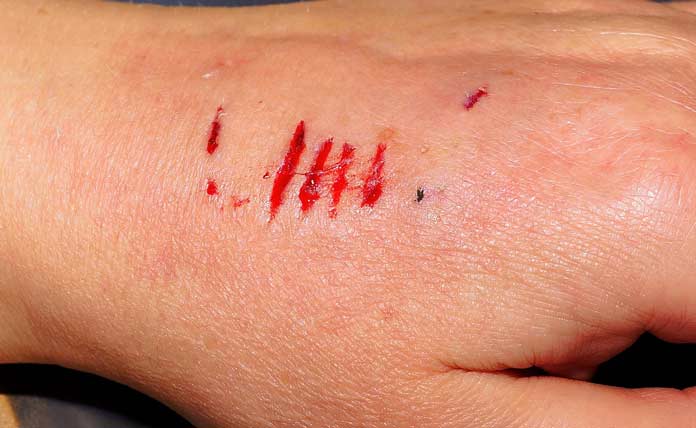Rabies is a disease that brings out horror scenes from fiction into reality. Although the occurrence of it in the United States is rare, contracting it is relatively easy. Dogs have been the main culprit of Rabies in some countries such as the Philippines, but extensive vaccination in the United States has potentially eliminated dogs from being reservoirs of the virus.
According to the CDC or Centers for Disease Control and Prevention, Human cases in the United States are rare, with 1 to 3 cases reported annually. By definition, Rabies is a disease from animals that can infect humans through bites. Rhabdoviridae is the name of the virus that causes this terrible disease.
With a lot of dogs vaccinated in the United States, its reservoirs are mainly wild animals such as Raccoons, Bats, Skunks, Foxes, and Coyotes. Dogs and other pets who haven’t had any vaccinations that encounter these creatures have a high chance of contracting rabies.
What happens when Rabies Infects Humans?
The first symptoms of rabies often manifest itself in a few days. Those bitten by animals infected with rabies often have symptoms of fever, nausea, headaches, and vomiting. When the infection is in the late stages, the victim begins to show the most identifying and classic symptoms of rabies which are:
- Excessive Salivation
- Confusion
- Body Malaise (Muscle Ache)
- Hydrophobia (Fear of Water)
- Dysphagia (Difficulty in Swallowing)
- Auditory and Visual Hallucinations
What do you do if a Person is already in the Late Stages of Rabies?
At the onset of the bite from an animal suspected to have rabies, immediately seek medical help. The best way to treat the infection is by giving anti-rabies shots immediately after exposure. However, if a person reaches the final stage, it’s best to put the person away from other people as Rabies is highly contagious.
Rabies can infect people through airborne droplets that are naked to the eye. If you want to help a person with the disease, immediately submit yourself for vaccination. A person infected with rabies in the late stages typically dies, as there is no real cure for the illness.
Also Read: Ultimate Guide to Immunization in Children—Importance, Schedule and Side Effects
Other Modes of Transmission
In the rarest occasions, CDC reports that there have been cases of humans infected with rabies via organ transplant. March 15, 2013, the organization confirmed the death of a Maryland resident due to rabies from a raccoon bite. Infection occurs when the donor is infected and proceeds with the donation.
Although there are strict methods in screening donors, and there isn’t much attention given towards rabies unless suspected. The reason for this is that screening for diseases is time-consuming, which may allow the organ to deteriorate and become useless for transplant.

The Milwaukee Protocol
On September 12, 2004, a young girl by the name of Jeanna Giese, a student from Wisconsin, picked up a bat while going to church. The bat was rabid, and Jeanna sustained a small bite on her index finger. Although the wound got cleaned with Hydrogen Peroxide, the family decided not to seek medical attention.
After more than 37 days, Jeanna started developing the classical symptoms. Jeanna reminded everyone that a bat bit her the past month and transferred to a larger hospital. The diagnosis eventually turned out to be Rabies which the CDC confirmed.
As the situation looked dire, Jeanna’s family and doctors decided to try out a controversial method in an attempt to cure her of rabies. The procedure involved Jeanna being put in a chemically induced coma to slow down the infection. In theory, the whole point of the coma was slowing down the progression of the virus and allow the body to develop antibodies against the virus.
Although she did require physical therapy, Jeanna miraculously survived and went on to a complete recovery. However, the Milwaukee Protocol remained controversial because it had been a failure in the next trials and that the survival rate remained relatively small. Jeanna is the only person in the world to have survived rabies without ever receiving a vaccine. To this day, there have been only three known survivors.
Takeaway
Although there’s a lot that HMO’s can do such as handle hospitalization, vaccines, meditouch EHR costs, providing medicines, etc., nothing can prepare them from late stage rabies. The symptoms of this terrible disease come straight out from a Hollywood horror. It’s best to seek medical treatment right away, after being exposed or bitten to rabies to prevent a dire situation from happening.
Rabies has no cure and is indeed a lethal disease. Even if Jeanna Giese underwent the controversial Milwaukee Protocol, it’s still not safe enough to conclude that treatment for rabies exists. Only vigilance and prevention are the surest ways on how people can avoid such a grizzly fate.
Further reading: What To Do When Someone Is Bitten By A Dog?

thanks for sharing very important informative post
You are welcome. Glad that you found this post informative.